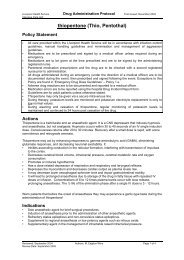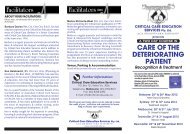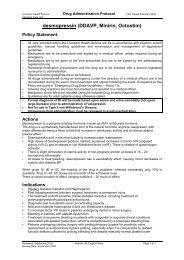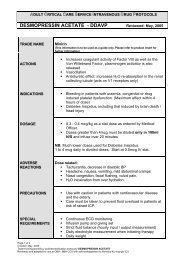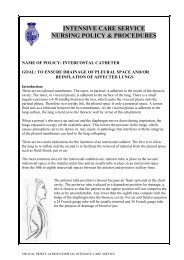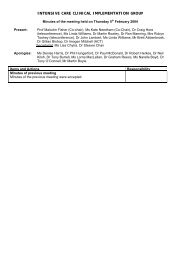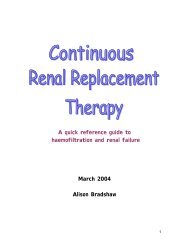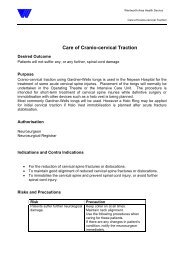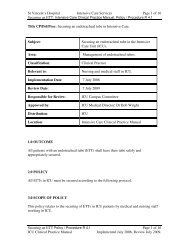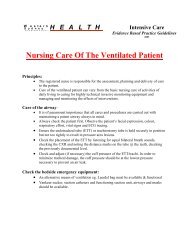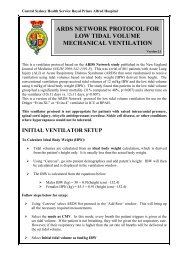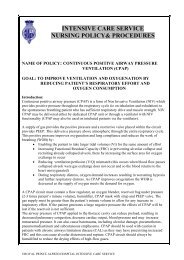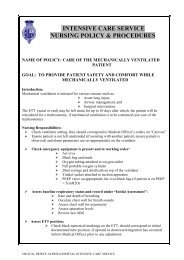Stabilisation of an Endotracheal Tube for the Adult Intensive Care ...
Stabilisation of an Endotracheal Tube for the Adult Intensive Care ...
Stabilisation of an Endotracheal Tube for the Adult Intensive Care ...
Create successful ePaper yourself
Turn your PDF publications into a flip-book with our unique Google optimized e-Paper software.
Clinical Practice Guideline<br />
1. Introduction<br />
Invasive ventilation is common practice in <strong>an</strong> intensive care unit (ICU) <strong>for</strong> patients with<br />
serious breathing difficulties. Ventilation is achieved through <strong>the</strong> insertion <strong>of</strong> <strong>an</strong> ETT into <strong>the</strong><br />
trachea via <strong>the</strong> mouth or nose <strong>an</strong>d attaching this tube to a ventilator. It is vitally import<strong>an</strong>t<br />
that <strong>the</strong> position <strong>of</strong> <strong>the</strong> ETT remain stable <strong>for</strong> several reasons:<br />
1. as this tube is fulfilling <strong>the</strong> function <strong>of</strong> a patient’s airway, <strong>the</strong> unexpected removal<br />
<strong>of</strong> <strong>the</strong> tube (unpl<strong>an</strong>ned extubation UEX) poses a signific<strong>an</strong>t risk to <strong>the</strong> patient’s<br />
survival;<br />
2. <strong>the</strong> tube needs to be stable to ensure optimal ventilation <strong>an</strong>d const<strong>an</strong>t supply <strong>of</strong><br />
oxygen; <strong>an</strong>d<br />
3. ETT movement within <strong>the</strong> trachea may cause local trauma <strong>an</strong>d is a signific<strong>an</strong>t<br />
source <strong>of</strong> discom<strong>for</strong>t <strong>for</strong> <strong>the</strong> patient.<br />
There are also several clinical concerns to address with respect to patient safety when<br />
attempting to achieve a stable ETT. These include:<br />
1. Preventing migration <strong>of</strong> <strong>the</strong> ETT <strong>an</strong>d unpl<strong>an</strong>ned extubation;<br />
2. Maintaining alignment <strong>of</strong> <strong>the</strong> ETT within trachea;<br />
3. Skin integrity <strong>of</strong> <strong>the</strong> face <strong>an</strong>d neck; <strong>an</strong>d<br />
4. Mainten<strong>an</strong>ce <strong>of</strong> adequate levels <strong>of</strong> venous return from <strong>the</strong> head through <strong>the</strong> jugular<br />
veins.<br />
There are three main methods <strong>of</strong> achieving tube stabilisation: 1) tying <strong>the</strong> ETT to <strong>the</strong><br />
patient’s head using white cotton tape; 2) taping <strong>the</strong> ETT to <strong>the</strong> patient’s face using medical<br />
adhesive tape; or 3) using a commercial tube holder. There is a lack <strong>of</strong> research into <strong>the</strong><br />
most effective <strong>for</strong>m <strong>of</strong> ETT stabilisation with a recent systematic review being unable to<br />
identify a superior method (Gardner, Hughes et al. 2005). A recent survey <strong>of</strong> NSW ICUs <strong>an</strong>d<br />
High Dependency Units (HDUs) with <strong>the</strong> capacity to provide short term ventilation was<br />
conducted to determine local ETT m<strong>an</strong>agement practices [see Appendix 2]. Particip<strong>an</strong>ts<br />
from 41 <strong>of</strong> <strong>the</strong> 44 eligible units responded (response rate 93%). The white cotton tape<br />
method was <strong>the</strong> most frequently reported method <strong>for</strong> stabilising <strong>the</strong> position <strong>of</strong> <strong>an</strong> ETT<br />
(78%, n=32) however nine units reported using this method in conjunction with a<br />
commercial product <strong>an</strong>d a fur<strong>the</strong>r seven units reported using this method in conjunction with<br />
medical adhesive tape. Renewing or ch<strong>an</strong>ging <strong>the</strong> ETT tapes is a procedure completed<br />
frequently by critical care nurses, however, only 41% (n=17) <strong>of</strong> NSW ICUs/HDUs had a<br />
7




